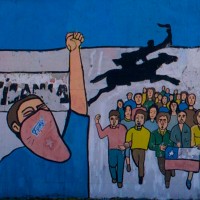I found this wonderful graffiti painted on the wall of the main river in Santiago (Mapuche River). My Spanish is dog poor and my knowledge of Chilean history is gleaned from recent readings. However, the always-brave blog poster that I am, I will try to translate these pictures. The graffiti covers the workers’ struggle for rights and the ensuing cruel actions of certain governments.
The text portion on the left is written by Noble Prize winning Chilean poet Pablo Neruda (1904-1973). My poor Spanish tells me it is about brotherhood being permanent. Next to this are protestors holding up signs saying to stop abuses. Pablo Neruda’s house is a stop for most tourists and we marched in unison.
The next portion of the painting is about the 1907 Santa María School massacre in which the government killed striking miners and their families. They were mining for the hot commodity of the day – saltpeter, better known as nitrate. The government hid the massacre from the people so the number of dead is tough to know, but most estimates are about 2,000 dead.
I have no clue who is painted in a fedora. Any Chilean readers wish to help me? The final section is a reference to the 1904 “Meat” Massacre in Santiago. The workers revolted against the central government due to an increase in the price of meat and the general soaring cost of living. The government responded by sending in the army. Two more days of riots followed and hundreds of civilians were killed on the streets.
The initial white poster in the second panel refers to “The Century”, which is a Chilean Communist Party newspaper. It struggled to keep publishing while right wing governments tried to close it in 1949 and 1973. It can now be found on the web. The guy with the cool black-framed glasses (We saw them at the national museum) is Salvador Allende. He was involved in politics for 40 years and ran 3 failed presidential runs before being elected in 1970. His “if you fail, try again” strategy did not end particularly well for him. During his brief time in power, he pushed for nationalization. Eventually he was cornered by army troops in the Presidential Palace. He shot himself. After that, the army leader Pinochet brutally ruled the country for almost two decades.
I do not profess to understand Chilean history, but it seems the US often backs the wrong guy? Chile was in a struggle between capital and labor. Capital controlled the government giving labor little outlet. Communism’s allure to the average Chilean was possible wealth distribution and a chance at a better life. But this struggle was seen by Nixon as another Cuba – another chance for the USSR and the USA to decide which way a domino fell. The problem was that the superpowers’ play for control hurt Chile. The US helped Allende’s ouster and Chile was given 20 years of a cruel dictator who killed thousands of people.
The last half of this second panel shows the peace and prosperity during the Allende leadership. Allende was not in office long enough for much economic change.
The start of this last panel shows the burning of the Presidential palace and the eventual death of Allende. Pinochet is given a fleeting reference as the black and white image. The remainder of the wall is the various forms of protest from art, to marches, to songs, to more violent clashes. Eventually the conflict came to a boil and in 1988 Pinochet ran a vote to see if there would need to be a vote. Seems odd? He thought he had it in the bag, but lost and thus began his slow release of power.
During this period of cruel leadership, Pinochet and Chile had become an experiment for the University of Chicago’s economics principles. They copied the course of Thatcher in the UK. This gave the Chilean economy a stronger footing than many of their neighbors. But that came at the huge cost of the Pinochet regime. Today some Chileans still feel the economy has plenty of room to improve, despite the country already being touted as the miracle of South America.




6 Responses to Chilean Workers’ Struggle (1900s)